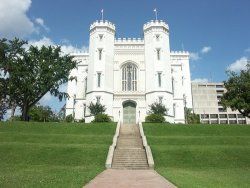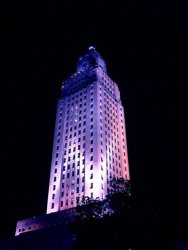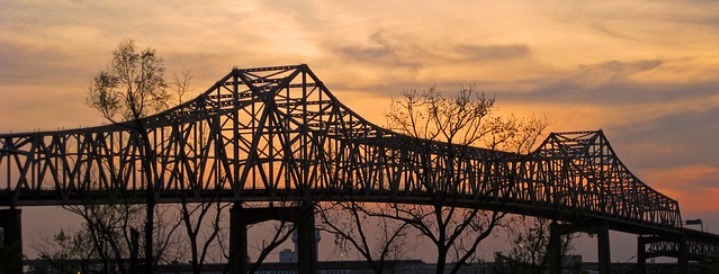2025 Baton Rouge Visitors Guide
Baton Rouge. Just the sound of it conjures up images of a gracious city known for its notions of the Old South. The city didn’t start out with such a genteel beginning though especially when you consider how it got its name. Legend has it that in 1699 a French explorer named Pierre Le Moyne, Sieur d’lberville led an expedition along the Mississippi River and came across a red pole (baton rouge) stained with the blood of fish and animals. This pole served as the dividing line between the Bayougoula and Houmas Indians and it was on this site that the city began to take shape.

Because of its location on the Mississippi River, Baton Rouge hosted many different people from many different nationalities and cultures. Evidence of these different ethnicities is still evident today in the cultural traditions of food, language, arts, and architecture. Baton Rouge’s rich cultural traditions can be seen in its unique attractions, heard in the Zydeco, Blues, and Cajun music, and tasted in the unique blend of Creole, African-American, French, and Spanish cuisine.
The town grew with the influence of Spanish, British, and French influence until it was eventually named the state capital in 1846. Louisiana seceded from the Union in 1861 at the beginning of the Civil War, and in August 1862, Baton Rouge fell to the Union forces. The federal government of Louisiana was moved to New Orleans but in 1882 Baton Rouge again became the capital of the state.
At the beginning of the 20th century, Baton Rouge saw the arrival of the Louisville, New Orleans, and Texas Railroad which catapulted the city into an age of progress. Many of the most important initiatives included the construction of a new waterworks, widespread electrification of homes and businesses, and the passage of several large bond issues for the construction of public buildings, new schools, paving of streets, drainage and sewer improvements, and the establishment of a scientific municipal public health department.
Today Baton Rouge is a community where life provides pleasure, opportunity, and growth to its visitors and residents in lifestyle and in business through innovative thinking and new relationships. A mix of the old and the new blends favorably in Baton Rouge where some of the world’s most advanced industrial facilities brush up against antebellum mansions. Technology has been most welcomed in Baton Rouge and has made its footprint on this city which also respects and retains the charm and heritage of the Old South.
Baton Rouge Fast Facts
- Population: The current population of Baton Rouge will be unknown until the next census in 2006. Before Hurricane Katrina in September of 2005, the population was 415,000. Now it is estimated between 800,000 and 1,000,000 based on 235,000 evacuees from the New Orleans area; 160,000 people staying in private homes with family and friends; 41,000 in leased apartments or houses; 32,000 in hotels and motels; 20,000 in shelters; and 10,000 in unsold new homes, college dormitories, and other facilities.
- Median Household Income: $30,368
- Median Family Income: $40,266
- Per Capita Income: $18,512
- Latitude: 30°27’29” North
- Longitude: 91°8’25” West
- Baton Rouge is on Central Standard Time and observes Daylight Savings Time.
Baton Rouge Attractions
Louisiana State Capitol
The Louisiana State Capitol building was the dream of Governor Huey P. Long and built in a short 14 months. Completed in 1932, the Capitol stands on a 27-acre tract and its 450 feet height and 34 floors allow it to retain the title of the tallest capitol in the United States. The historic building includes the Hall and the Senate and House Chambers and an Observation Deck on the 27th floor where visitors can overlook the city of Baton Rouge. Sadly, Governor Long was assassinated in his dream building in 1935. Alligator Bayou Swamp Tours

Just a few short miles from Baton Rouge lies another world of deep mystery and creatures that lurk in swamps. If you are ready for an adventure, cruise into the wild beauty of the Spanish Lake Basin, a primitive wilderness of swamps, bayous, and lakes teeming with alligators, birds, cultural history and the Cajun lifestyle for which Louisiana is famous. Typical wildlife includes alligators, birds, turtles, nutria, and other animal species. Alligator Bayou invites you to explore and learn on a swamp tour and just have a great time entertaining your next corporate or private event on the bayou pavilion.
Houmas House
No visit to Louisiana would be complete without seeing an antebellum mansion. Houmas House Plantation and Gardens promises a genteel experience with all the charm and history of a pre-Civil War era home restored to perfection. The mansion is renowned for its architectural details and the elegant furnishings and accouterments that still grace its rooms to perfection. Outside the Houmas House Gardens cover 12 acres and feature The Hampton Garden, The Upper Garden and The Croquet Lawn where visitors may stroll and take in the natural Louisiana flora beautiful in every season of the year.
Blue Bayou Waterpark/Dixie Landin’ Amusement Park
Blue Bayou Waterpark is the only place to cool off during the hot Cajun summers. Splash to your heart’s content and drench your friends… it’s all fair at the waterpark! If you’re looking for excitement, don’t miss the Mad Moccasins but if you want to relax a bit, the Atchafalaya Run is just what you need. When you’re ready to dry off, step next door to the Dixie Landin’ Amusement Park located on 80 acres at I-10 and Highland Road in Baton Rouge. You’ll find fun for the whole family with its thrilling rides, games and much, much more!
Baton Rouge Zoo
The number-one family attraction in the Baton Rouge area is the amazing Baton Rouge Zoo. You can expect to see over 1,800 animals at home including alligators, elephants, giraffes, flamingos, and white tigers. Other attractions include The Otter Pond, L’aquarium de Louisiane, colorful Parrot Paradise, New Safari Playground, KidsZoo, the Cypress Bayou Railroad, White Tiger Tram, Safari Post gift shop and the Flamingo Café.
Recreations & Leisure
Argosy Casino
Re-live the days of the riverboat tall ships at The Argosy Casino located on the Mississippi River in the downtown historic district across from the convention center. The three-deck riverboat casino features over 29,000 square feet of gaming area including over 800 slots, video poker, keno machines and table games including live poker, blackjack, Caribbean Stud Poker, mini-baccarat, roulette, craps, and Let-it-Ride. Fabulous food and entertainment are also part of the casino’s attractions ensuring fun and enjoyment for visitors of all ages.
Beaver Creek Golf Course
Located only 20 minutes from downtown Baton Rouge off of Hwy. 61 in Zachary, Baton Rouge’s Beaver Creek Golf Club is an outstanding 18-hole public golf facility featuring a windswept front nine and a sheltered back nine that meanders through protected wetland areas. The par 72 layout will provide golfers with many unique shot-making opportunities. A lighted driving range, a large putting green, and a short wedge chipping area should help you shave a few strokes off your next round. Professional instruction is available for those who would like to improve their game.
Farr Park Horse Activity Center
Farr Park is home to a fine equestrian facility, offering horseback riding as well as a wide variety of equestrian events, such as rodeos, ropings, and horse shows. The park also has a campground adjacent to the Mississippi River, located on historic River Road where its amenities include more than 180 camping sites, water and power hookups, restrooms, showers, and laundry facilities.
Wanateri Lakes
Situated on the banks of the Amite River, the park includes a large scenic lake with ancient cypress trees covering a perfect fishing spot or creating an ideal location to simply enjoy the beauty of nature. Enjoy the overnight facilities for a weekend or holiday on the lake as you camp, barbeque or walk the trail to the scenic beaches. You can also bring your own horse or rent one for a trip on some of the trails through naturally wooded areas and the beach. Horseback riding lessons are offered by a qualified instructor for those who would like additional instruction.
Baton Rouge Arts
Baton Rouge Symphony
In this area known primarily for its zydeco, jazz and swamp pop music, the Baton Rouge Symphony provides classical and symphonic sounds and is known throughout the country for its fine musical tradition and standards of excellence. The Baton Rouge Symphony is also committed to providing educational and cultural enrichment for the people of the Greater Baton Rouge region and neighboring communities through its outreach programs and concerts.
Playmakers of Baton Rouge
Playmakers of Baton Rouge is the only professional theatre dedicated to bringing live theatrical productions to young Louisiana audiences. Founded in 1982, Playmakers brings entertaining opportunities to thousands of children and adults through its annual Summer Neighborhood Tour, Spring Elementary School Tour, Drama Classes, Season Productions, Summer Stock Workshops, and the Wally Wise Guy educational mini-tour.
Louisiana State Museum
The Louisiana State Museum is a 69,000-square-foot facility located on the corner of 4th Street and Spanish Town Road, across from the Capitol Gardens. The museum’s permanent exhibits will highlight those aspects of Louisiana’s history that are nationally significant, as well as those aspects that are unique to the state’s culture. A large gallery will house a permanent collection as well as changing or traveling exhibitions.
Baton Rouge Restaurant Guide
With more than 600 restaurants representing cuisine from around the world, Baton Rouge has earned a reputation for pleasing the most discriminating palettes. From fresh seafood to sizzling steaks, the cool Caribbean to authentic Italian, Baton Rouge has a wonderful selection of entrees to suit your taste and budget. So whether you’re looking for an elegant dining room, a shady sidewalk café, a colonial tavern or a cozy bistro, Baton Rouge has a wonderful table just waiting for you. Some of the most popular restaurants include Avoyelles Restaurant, Belle of Baton Rouge Atrium Buffet, Café Americain Restaurant & Bar, Champps, City Café Plaquemine, Claiborne Restaurant of Louisiana, Lonestar Steakhouse and Saloon, New Orleans Poboy and Gyros, and Raoul’s Deli.

Getting to Baton Rouge
Baton Rouge is located in Southeast Louisiana, 157 miles north of the Gulf of Mexico and 80 miles West/NorthWest of New Orleans via Interstate 10. Baton Rouge is also served by Interstate 12, Interstate 55, Interstate 59 and Interstate 49. Public transportation is available through the Capital Area Transit System and air travel is accessible via the Baton Rouge Metro Airport.
Communities
Baton Rouge is in good company surrounded by other progressive cities and towns in the area including Addis, Baker, Brusly, Bueche, Denham Springs, Duplessis, Galvez, Gardere, Gonzales, Greenwell Springs, Iberville, Inniswold, Old Jefferson, Plaquemine, Port Allen, Prairieville, Saint Gabriel, Scotlandville, Watson, Zachary and Zion City.
